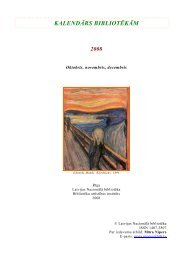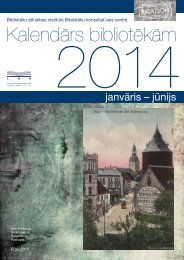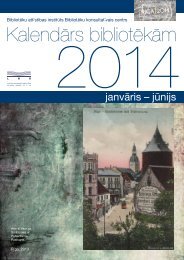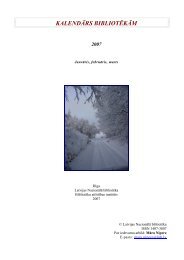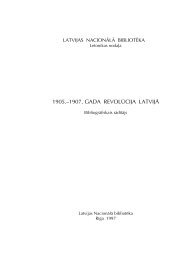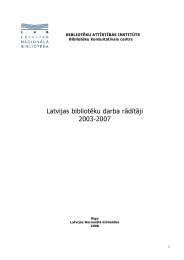LAIKU ATŠALKAS: ŽURNĀLISTIKA, KINO, POLITIKA - Academia
LAIKU ATŠALKAS: ŽURNĀLISTIKA, KINO, POLITIKA - Academia
LAIKU ATŠALKAS: ŽURNĀLISTIKA, KINO, POLITIKA - Academia
You also want an ePaper? Increase the reach of your titles
YUMPU automatically turns print PDFs into web optimized ePapers that Google loves.
<strong>LAIKU</strong> ATŠALKAS: ŽURNĀLISTIKA, <strong>KINO</strong>, <strong>POLITIKA</strong>Ingus BērziņšDoctoral student, University of Latvia, Department of Communications StudiesTHE LTV BROADCAST “VIDEO RHYTHMS” (1984-1987):A TELEVISION MESSENGER ABOUT THE FUTURE OFNON-CENSORSHIPKeywords: Television broadcast “Video Rhythms,” TV content, Soviet television, censorship, pop music,Jānis Šipkēvics, Juris PodnieksThis paper focuses on the content of the “Video Rhythms” broadcast on Soviet Latviantelevision during several segments of its existence. The author has interviewed the producersof the show to find out how their understanding and that of the censors of LTV changed on theeve of an age of non-censorship in Latvia in terms of what was permissible in the content of theSoviet media.When it comes to the audience of a totalitarian media system, general principles about thedesires of the audience and the satisfaction of those desires can be brought to bear. Theoreticalmodels as to the satisfaction of audience needs point to many important needs that are satisfiedby people who use the media. These include the desire to be entertained, to share one’s experiencewith others, to be informed, to satisfy curiosity, to find models to imitate, and to obtainan identity. Presumably, “Video Rhythms” filled an empty niche in terms of the needs whichyoung people in Soviet Latvia experienced during the early 1980s. These young people werepart of a larger group – the young people of the entire world in terms of global values insofar aspop culture was concerned, as well as the lifestyle which they had in common.The author analysed the content of three episodes of the broadcast – one from its early days,one from the middle of its period of broadcasting, and one which was shown toward the end ofits life. He also conducted in-depth interviews with the producers of the show, finding that overthe course of three or four years, those who produced content for Soviet Latvian television andthose who censored them changed their opinions as to what was permissible in terms of Sovietmedia content.The way in which the audience was addressed on the show underwent particularly importantchanges. If the hosts initially were weighty and with wooden expressions on their faces, thenlater they were playful, friendly, and respectful of what their viewers knew. As the overallunderstanding of that which was acceptable in Soviet media content changed, moreover, it wasno longer necessary in the latter days of the programme to pay tithes to Soviet censorship. Nolonger did the producers have to include comments from propaganda experts about the “darksides” of capitalist music and the related business.231



